The seven indigenous peoples of Nicaragua are distributed, historically and culturally, between the Pacific coast, central and northern Nicaragua – inhabited by the Chorotega (221,000), Cacaopera or Matagalpa (97,500), Ocanxiu or Sutiaba (49,000) and Nahoa or Náhuatl (20,000) peoples – and the Caribbean (or Atlantic) coast, inhabited by the Mískitu (150,000), Sumu-Mayangna (27,000) and Rama (2,000) peoples. Other peoples who have collective rights under the Constitution of Nicaragua (1987) are the Afro-descendants, referred to as “ethnic communities” in the national legislation. They include the Creoles or Kriols (43,000) and the Garífunas (2,500).
In 1979, the Sandinista National Liberation Front (FSLN) came into power in Nicaragua, and later had to face an armed front supported by the United States. The indigenous peoples of the Caribbean coast, principally the Mískitus, participated in the armed opposition to the FSLN. In 1987, in order to put an end to the indigenous resistance, the FSLN created the Northern and Southern Autonomous Regions of the Caribbean (Atlantic) Coast (RACCN/RACCS), based on a New Constitution and an Autonomy Statute (Law 28). As a result of the judgment of the Inter-American Court of Human Rights in the case of the Mayangna (Sumo) Awas Tingni Community vs. Nicaragua in 2001, Law 445 was enacted on the Communal Property Regime of the Indigenous Peoples and Ethnic Communities of the Autonomous Regions of the Atlantic Coast of Nicaragua and of the Bocay, Coco, Indio, and Maíz Rivers. That law, as of 2003, also clarified the right to self-governance in the communities and created a procedure for the granting of title to the territories. As of 2005, the state initiated the title-granting process for the 23 indigenous and afro-descendant territories in the Autonomous Regions, culminating with delivery of the ownership titles in the year 2013. In addition, the General Education Act of 2006 recognized a Regional Autonomous Educational System (SEAR). In 2007, Nicaragua voted in favour of the United Nations Declaration on the Rights of Indigenous Peoples (UNDRIP) and in 2010 it ratified ILO Convention 169.
International Work Group for Indigenous Affairs, The Indigenous World 2019



